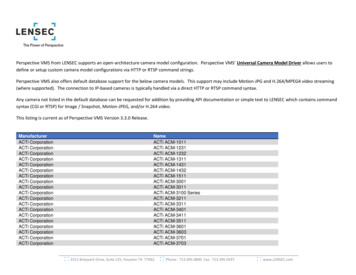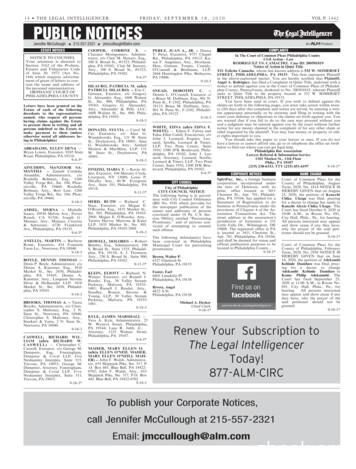Emergency Support Function #2 – Communications Annex
Emergency Support Function #2 – Communications AnnexSupport Agencies:ESF Coordinator:Department of HomelandSecurity/National Protection andPrograms Directorate/Office ofCybersecurity and CommunicationsPrimary Agencies:Department of AgricultureDepartment of CommerceDepartment of DefenseDepartment of Homeland SecurityDepartment of the InteriorFederal Communications CommissionGeneral Services AdministrationDepartment of HomelandSecurity/National Protection andPrograms Directorate/Office ofCybersecurity and CommunicationsDepartment of HomelandSecurity/Federal EmergencyManagement AgencyINTRODUCTIONPurposeEmergency Support Function (ESF) #2 – Communications supports the restoration ofcommunications infrastructure, coordinates communications support to response efforts,facilitates the delivery of information to emergency management decision makers, andassists in the stabilization and reestablishment of systems and applications duringincidents.ScopeESF #2 acts to meet the telecommunications and essential elements of informationneeds of local, state, tribal, territorial, insular area, and Federal Government agencies;nongovernmental organizations; industry essential service providers; other private sectorpartners; and individuals, families, and households, including individuals with disabilitiesand others with access and functional needs. The following are responsibilities of ESF #2: Provides disaster emergency communications, which consists of the technical meansand modes required to provide and maintain operable and interoperable voice anddata communications in an incident area. Supports the temporary reestablishment of the basic public safety communicationsinfrastructure and assists in the initial restoration of the commercialtelecommunications infrastructure. Coordinates the provisioning of priority and other telecommunications services atincident support facilities, provides capabilities and services to aid response andshort-term recovery operations, and ensures a smooth transition to long-termrecovery efforts. Leads communications planning, training, exercising, and coordination of theenterprise capabilities of the Federal Government to support a whole ofgovernment approach to disaster response.June 2016ESF #2 – Communications AnnexESF #2-1
Emergency Support Function #2 – Communications Annex Facilitates the delivery of mission critical information to maintain situationalawareness for emergency management decision makers and support elements. Develops and maintains a cyber and communications common operating picture withfederal, state, and industry partners. Develops cyber and communications restoration priorities during disasters. Coordinates and deconflicts incident radio frequencies in disaster event areas ofoperation.The ESF #2 structure may be used in non-Stafford Act and non-disaster situations wherethe National Response Framework applies.RELATIONSHIP TO WHOLE COMMUNITYThis section describes how ESF #2 relates to other elements of the whole community.Basic concepts that apply to all members of the whole community include:Local, State, Tribal, Territorial, and Insular Area Governments Gain situational awareness through reporting that occurs at each level: from local,state, tribal, territorial, insular area, and Federal governmental agencies;nongovernmental organizations; industry essential service providers; other privatesector partners; and residents. Information and support requests generally flow fromthe incident level, though operations and coordination centers, to decision makers. Atthe same time, decision makers and operations and coordination centers provideaccurate, actionable, and relevant information to support incident operations. Initiate actions to save and sustain lives, reduce human suffering, and provideadditional resources and assistance to response efforts. ESF #2 accomplishes this byproviding assistance to stabilize and reestablish critical communications infrastructurequickly and efficiently, coordinating requests for additional support, identifying andintegrating resources and capabilities, and coordinating information flow.Local authorities are responsible for obtaining required waivers and clearances related toESF #2 support.Private Sector/Nongovernmental OrganizationsThe private sector owns or operates most of the Nation’s communications infrastructureand is a partner and/or lead for the rapid restoration of their networks.Through planning and coordination, private sector entities provide critical information forincident action planning and decision making during an incident. Private sector mutual aidand assistance networks also facilitate the sharing of resources to support response.ESF #2-2ESF #2 – Communications AnnexJune 2016
Emergency Support Function #2 – Communications AnnexFederal GovernmentCommunications management primarily occurs on a bottom-up basis—decisions are madeat the lowest level possible; only issues requiring adjudication or additional resources arereferred to the next higher management level. Issues of national security may also behandled at a higher level.Agencies that provide communications assets in support of incident response controltheir own organic assets and coordinate location and use with the Disaster EmergencyCommunications (DEC) Group.Specific information on Federal Government actions are described in the following section.CORE CAPABILITIES AND ACTIONSESF Role Aligned to Core CapabilitiesESF #2 supports the core capability of Operational Communications. The following tablelists specific ESF #2/agency actions that support this capability. Though not listed in thetable, all ESFs, including ESF #2, support the core capabilities of Planning, OperationalCoordination, and Public Information and Warning.Core CapabilityESF #2 – CommunicationsOperationalCommunications Coordinates with state and federal partners to ensure the capacityto communicate with both the emergency response communityand the affected populations. Coordinates the establishment of interoperable voice and datacommunications between local, state, tribal, territorial, insulararea, and Federal first responders. Re-establish sufficient communications infrastructure within theaffected areas to support ongoing life-sustaining activities; providebasic human needs, including the needs of individuals with disabilitiesand others with access and functional needs; and transition torecovery.June 2016ESF #2 – Communications AnnexESF #2-3
Emergency Support Function #2 – Communications AnnexAgency ActionsPrimary AgencyActionsDepartment ofHomeland Security(DHS)National Protection and Programs Directorate/Officeof Cybersecurity and Communications Coordinates the planning and provision of nationalsecurity/emergency preparedness (NS/EP) communications for theFederal Government under all circumstances, including crisis oremergency, attack, stabilization, and reestablishment. Coordinates the restoration of communications infrastructure andsupports Federal departments and agencies in procuring andcoordinating NS/EP communications services. Coordinates with the Federal Emergency Management Agency(FEMA) and support agencies to develop ESF #2documentation, policies, and procedures. Coordinates with FEMA and support agencies to train and deploypersonnel to support ESF #2 operations. Acts to achieve, maintain and enhance interoperable emergencycommunications capabilities; and to support and promote the ability ofemergency response providers and relevant government officials tocommunicate in the event of natural disasters, acts of terrorism, andother man-made disasters.Provides a consultative structure to coordinate the cybersecurityactivities of participating agencies and ensures the Federal agencieshave access to and receive information and intelligence needed toexecute their respective cybersecurity missions. Provides shared situational awareness and recommendations oncybersecurity risks, incidents, analysis, and warnings for Federal andnon-Federal entities to enable real-time, integrated, and operationalactions. Provides timely technical assistance, risk management support, andincident response capabilities to Federal and non-Federal entitieswith respect to cybersecurity risks and incidents, which may includeattribution, mitigation, and remediation.Federal Emergency Management Agency ESF #2-4Activates Federal ESF #2 under the Stafford Act as required.Provides short-term restoration support to local, state, tribal,territorial, and insular area government emergency communications. Provides personnel to support ESF #2 operations. Provides communications support to local, state, tribal, territorial,and insular area first responders as requested by the StateCoordinating Officer and as approved by the Federal CoordinatingOfficer. Coordinates activities to assist with the restoration of public safetycommunications systems and first responder networks asrequested by the State Coordinating Officer and approved by theFederal Coordinating Officer. Provides communications and information technology (IT) to Federalresponse/recovery facilities within the area of operation.Coordinates with the Office of Cybersecurity and Communications(CS&C) and support agencies to develop appropriate documentation,policies, and procedures.ESF #2 – Communications AnnexJune 2016
Emergency Support Function #2 – Communications AnnexSupport AgencyActionsDepartment ofAgriculture/ForestService andDepartment of theInteriorProvides communications resources, including:Department ofCommerceDepartment ofDefense Radio communications systems to support firefighters, lawenforcement officers, and incident response operations. Engineers, technicians, and liaison staff to assist the DEC Group. A communications officer to accompany radio systems for usertraining and operator maintenance indoctrination. Additional radio systems.National Interagency Radio Support systems for damagereconnaissance teams and other applications.National Telecommunications and Information Administration Manages the use of the Federal radio frequency spectrum.Coordinates Federal radio frequency interoperability.Coordinates Federal telecommunications assistance to local, state,tribal, territorial, and insular area governments. Resolves radio frequency use conflicts. Promptly notifies the DEC Group of all communications requirementsand assets deployed to the incident area. Provides resources and capabilities to disaster response operationsupon request should other Federal resources and capabilities becomeoverwhelmed.Department ofHomeland SecurityOffice of Infrastructure Protection Provides situational awareness, cross-sector coordination, andprioritized recommendations regarding critical infrastructures andkey resources.General ServicesAdministration (GSA) Provides Regional Manager staffing support for disaster or eventresponse operations when requested by the Director, NationalCoordinating Center for Communications (NCC). The GSA Office of Mission Assurance ESF #2 Program Coordinatorcoordinates and authorizes deployment of Regional Managers.June 2016ESF #2 – Communications AnnexESF #2-5
Emergency Support Function #2 – Communications AnnexSupport AgencyActionsOther FederalA gencies ESF #2-6All other Federal agencies: Use organizational resources to meet their missionrequirements before requesting emergency communicationssupport. Notify the Regional Response Coordination Center (RRCC) orunified coordination staff promptly of all communicationsrequirements and available assets to eliminate the possibilityof service duplications and ensure prompt provision ofneeded services and facilities to the proper user. Coordinate with the RRCC or unified coordination staffwhen a representative of an organization at an incidentlocation has requested regional communications resourcesor support. Coordinate with the NCC as necessary for any requirednational-level communications support. Notify the RRCC or unified coordination staff of anyradio frequency devices being brought to the incidentarea. Notify the RRCC or unified coordination staff whencommunications resources are to be withdrawn ordiscontinued. Notify the RRCC or unified coordination staff whencommunications resources provided by ESF #2 are nolonger required.ESF #2 – Communications AnnexJune 2016
communications capabilities; and to support and promote the ability of emergency response providers and relevant government officials to communicate in the event of natural disasters, acts of terrorism, and other man-made disasters. Provides a consultative structure to coordinate the cybersecurity
2 Included but not documented functions agarchitransform-agarch support function. agarchlikelihood-agarch support function. agarchparametercheck-agarch support function. agarchstartingvalues-agarch support function. agarchtransform-agarch support function. aparchcore-aparch support function. aparchitransform-aparch support function. aparchlikelihood-aparch .
Axis Communications AXIS 215 PTZ-E Axis Communications AXIS 216FD Axis Communications AXIS 216FD-V Axis Communications AXIS 216MFD Axis Communications AXIS 216MFD-V Axis Communications AXIS 221 Axis Communications AXIS 223M Axis Communications AXIS 225FD Axi
land mobile radio for voice communications, comprehensive strategies for emergency communications must integrate the full Emergency Communications Ecosystem, including broadband, alerts and warnings, social media, and Next Generation 911. Internet Protocol-based devices and applications have the potential to vastly improve emergency
A communications-specific TTX is a forum to evaluate current communications plans, communications concepts, resources, and interoperable capabilities. The emphasis of a communications-specific TTX is on interoperable communications capabilities or gaps; interoperable communications assets in place, or their absence; and the use of
TALLAHASSEE, FLORIDA 32399-0950 MEMORANDUM: TO: FLORIDA EMS COMMUNICATIONS PLAN, VOLUME 1 RECIPIENTS FROM: CHARLES GHINI, DIRECTOR DIVISION OF TELECOMMUNICATIONS DATE: March 17, 2011 SUBJECT: FLORIDA EMERGENCY MEDICAL SERVICES COMMUNICATIONS PLAN, VOLUME 1 Fourth Edition The Florida Emergency Medical Services Communications Plan, Volume 1 has been
Emergency Nursing), and professional societies (e.g., Society for Academic Emergency Medicine, American College of Emergency Physicians, and Emergency Nurses Association). 3. Section 1. The Need to Address Emergency Department Crowding Many emergency departments (EDs) across the country are crowded. Nearly half of EDs report operating
Emergency Response Steps, and emergency contact and supply and equipment lists. Figure 10.21: Emergency Contact List (Sample), Figure 10.22: Emergency Vendor and Sources of Assistance List (Sample), and Figure 10.23: Emergency Supplies and Equipment (Sample) The Museum Emergency Planning Cycle (Figure 10.1) provides a visual )
Barb Emergency Physicians Barracuda Emerg Phy Best Care Emergency Phys Bge . Emcare Dtx Emergency Phys Emcare Iah Emerg Physicians Emerald Waters Inpatient Service Emergency Care Associates of Indiana Emergency Center at Timber Ridge Emergency Physician of Nashville Emergency Physicians Inc Excelcare Med Assoc























